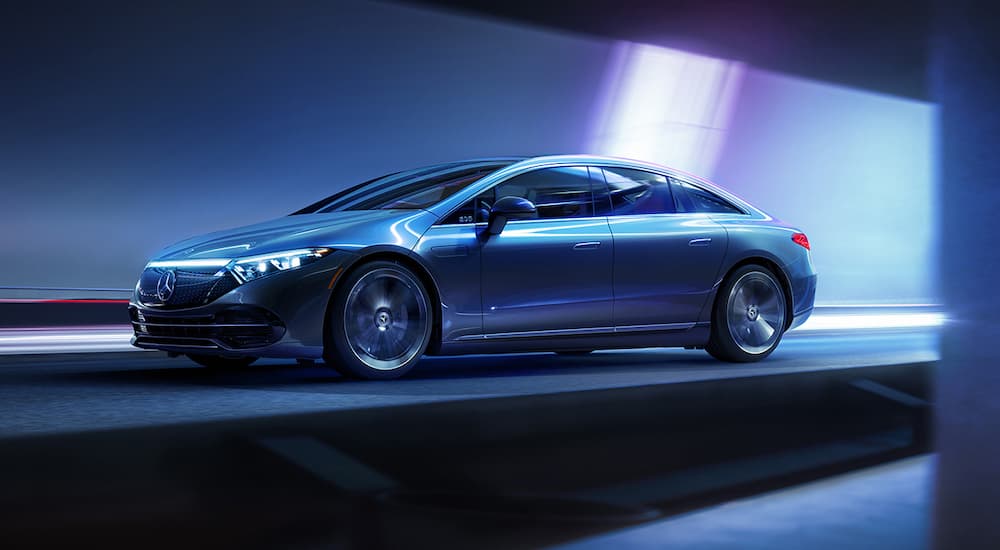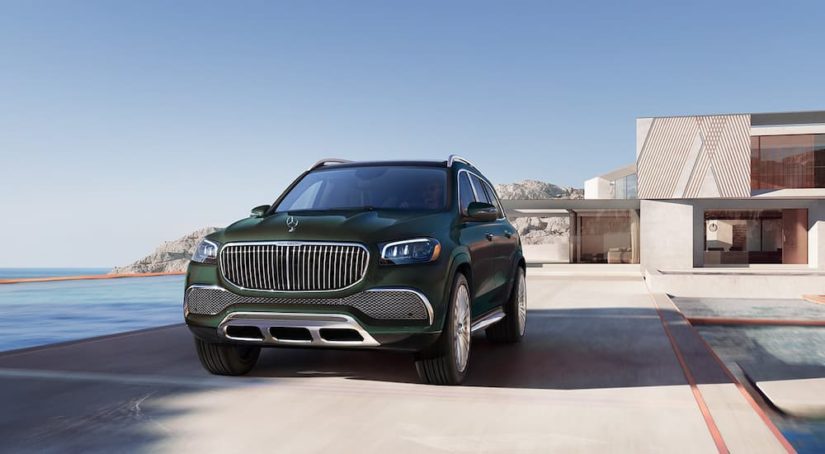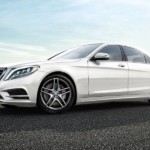Mercedes might be among the most prestigious names in the automobile industry, and almost anyone alive can recognize the three-pointed star, but that incredible name recognition doesn’t exactly extend to the brand’s models. Unless you are a car enthusiast (or at least a Mercedes fan), names like “S-Class” or “GLE” probably don’t mean much to you. Even if they are automotive icons, they just don’t have the ring of something like “Escalade” or “Continental.” If you are shopping for a new luxury car, you might be bewildered by the seemingly random strings of letters and numbers, but Mercedes model names do follow some easy-to-understand rules. Once you know the basics, it is relatively simple to identify the type and size of a Mercedes model by name.
The Three Points of the Star
The first thing to know about Mercedes, is that it is actually three different brands. They all use the three-pointed star, and their models share many similarities, but each brand has its own distinct take on building luxury automobiles. The parent corporation for all three brands was known as Daimler until February 2022, when it changed its name to the Mercedes-Benz Group to capitalize on Mercedes’s name recognition.
Daimler dates back to 1886, when Gottlieb Daimer, a former gunsmith, and Wilhelm Maybach, an engineer, built their first automobile. However, the two original partners never got to see the company they founded flourish. Gottlieb Daimler died in 1900 and Wilhelm Mayback left the company in 1907 to work for Count Ferdinand von Zeppelin, building engines for his rigid airships.
The Mercedes name made its appearance soon after Gottlieb Daimler’s death, with the unveiling of the Mercedes 35 PS in 1901. The revolutionary new vehicle was designed by Emil Jellinek, and he named the car after his daughter, Mercedes Jellinek. The new Mercedes soon made a new for itself in races, completely outclassing designs from other European brands. In 1926, Daimler capitalized on this reputation and applied the Mercedes name to all of its models.
Mercedes-Benz
Gottlieb Daimler was not the only German engineer to build his first car in 1896. Karl Benz took the automotive world by storm in the same year with his three-wheel Benz Patent-Motorwagen. Daimler and Benz soon became fierce rivals, but the two companies eventually merged in 1926. Today, Mercedes-Benz is the foundation for the other two Mercedes brands and offers the largest range of models, from sedans to SUVs. If you are looking for an all-around excellent luxury vehicle, Mercedes-Benz is the place to start.
Mercedes-AMG
Founded in 1967 as an independent tuning house dedicated to improving the performance of Mercedes models, AMG was acquired by Daimler in the 1990s and began producing new performance-focused models under the name Mercedes-AMG. “AMG” stands for “Aufrecht, Melcher, Großaspach” after its founders, Werner Aufrecht and Erhard Melcher–Großaspach was the city where Aufrecht was born. If you desire a high-performance luxury car, Mercedes-AMG is the brand for you.

Mercedes-Maybach
While Gottlieb Daimler may have been the founder of the company that bore his name, Wilhelm Maybach was the genius behind many of the brand’s engines. Even after he left the company, the Maybach name came to be synonymous with some of the most luxurious models on the road. Mercedes-Maybach became an official brand in 2014, manufacturing the most luxurious Mercedes models available. If pure opulence is your aim, Mercedes-Maybach will provide it.
Mercedes Model Names Explained
Today, SUVs make up roughly 70% of Mercedes sales, but when the brand’s model names were introduced, it was sedans that ruled the road. This means that the best starting place to understand Mercedes model names is with its sedan lineup. There are five distinct models that make up the core of the lineup, each distinguished by a letter. The letters aren’t in alphabetical order, but their relative positions are easy to remember.
- A-Class: This is the smallest Mercedes model and the only front-wheel drive model. The name does not appear to have any special meaning beyond being the first letter in the alphabet.
- C-Class: The smallest rear-wheel drive model in the Mercedes lineup, “C-class” simply stands for “Compact Class”
- E-Class: Occupying a middle of the road position between the C-Class and S-Class, the name of this midsize model stands for “Executive Class”
- S-Class: This is the largest and most luxurious model Mercedes sells, and the name “S-class” quite appropriately stands for “Special Class” (“Sondernklasse” in German)
Pretty simple, right? Even better, Mercedes crossover SUV model names use the same basic letters as Mercedes sedan model names, keeping everything neat and uniform. The only difference is that all crossover SUV models start with the letters “GL” for “Geländewagen Leicht” (which loosely translates to “Light All-Terrain Vehicle”) to distinguish them from sedans.
- GLA: A subcompact front-wheel drive model that is the direct counterpart to the A-Class sedan
- GLB: The only Mercedes crossover SUV that does not have a sedan counterpart in the American market, it corresponds to the B-Class sold in Europe and is slightly larger than the GLA
- GLC: Matching up to the C-Class sedan, the GLC is a compact rear-wheel drive SUV
- GLE: A midsize SUV model that is the direct counterpart of the E-Class sedan
- GLS: The largest Mercedes SUV model and a worthy counterpart to the luxurious S-Class
However, nothing can be that simple, and there are a few exceptions to the rules. Fortunately, these exceptions do follow some patterns, and they are mostly confined to some special models produced in smaller numbers. This includes four-door coupes, sports cars, and a dedicated luxury off-roader.
- G-Class: This boxy SUV is the original “Geländewagon” and there is nothing “Leicht” about it; the body-on-frame platform and solid rear axle allow it to conquer any terrain even if it is priced like an S-Class
- CLA / CLS: these two models are four-door coups that occupy similar positions as the A-Class (CLA) and S-Class (CLS). The “CL” part of the designation stands for “Coupe, Light” (“Coupe Leicht” in German).
- GT: This is a Mercedes-AMG only ultra-high-performance model and, as any car enthusiast knows, the letters “GT” stand for “Gran Tourismo” (Italian for “Grand Touring”) and are used for the fastest sports cars from many brands
The new Mercedes electric vehicles are also slightly confusing. All of these electric models have designations that begin with “EQ” (which Mercedes claims stands for “Emotional Intelligence”) and share the same pattern of letters used for other sedans and SUVs. However, the EQ lineup consists of both sedans and SUVs, and there is no way to tell them apart by the model names.
- EQB: A subcompact electric SUV that is similar to the GLB
- EQE: A midsize electric sedan that corresponds to the E-Class
- EQS: A full-size electric sedan that complements the S-Class
As the Mercedes EV lineup continues to grow, it seems likely that a new naming scheme will be needed in order to keep models straight. If electric vehicles become common enough, we might simply see the “EQ” dropped and traditional Mercedes model names used for EVs, but until that happens, things may get even more confusing. In fact, there are already rumors that there may soon be both an EQE sedan and an EQE SUV, though official model names for them have not yet been announced.

Why Can’t Luxury Brands Use Simple Names?
Outside of a few outliers, and the fact that Mercedes is actually three different brands, Mercedes model names are not that difficult to keep track of. Names with “Class” in them are sedans (except for the iconic G-Class), names starting with “GL” are crossover SUVs, and names starting with “EQ” are electric vehicles. The use of the letters A, B, C, E, and S to represent different segments is also fairly easy to remember, even if they aren’t in perfect alphabetical order.
Still, the convoluted naming schemes used by luxury automobile brands like Mercedes seem intentionally designed to create an aura of mystery and exclusivity rather than clearly label their lineups. This seems particularly true when the truly exclusive brands like Bentley and Rolls-Royce continue to use actual model names such as Flying Spur, Bentayga, Cullinan, and Wraith rather than arcane acronyms. While Mercedes has used its naming scheme long enough that it has become tradition, we aren’t sad to see other brands like Lincoln and Cadillac returning to more easily remembered names.



